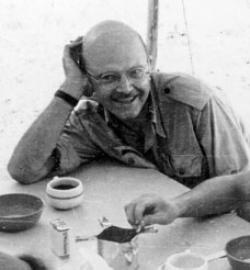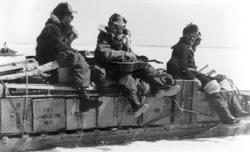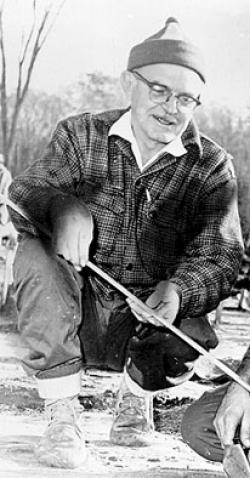


The death of J. Norman Emerson in Toronto on November 18, 1978, has saddened his many friends and removed from our midst an important intellectual force instrumental in establishing a unique tradition in Canadian archaeology. Indeed, his death marks the passing of an era.
Born March 13, 1917, son of an electrician, Norman grew up in Toronto, where he emerged from Rose Avenue Public School to earn entry into the prestigious University of Toronto Schools, 1932--1936. Here he was not only successful scholastically, but he also became an accomplished fencer, winning several medals. He then entered Trinity College, University of Toronto, 1936- 1940, where he specialized in Sociology and graduated 1: 1 in his final year. As an undergraduate, Norman broke from his essentially "wasp-ish" background, and states (1974d:2) that "At about age 20, despite the growing popularity of the Oxford Group, I dissociated myself from the Anglican Church, to allow more time for skiing. "
The summers of 1938 and 1939 also appear to have indelibly influenced Norman's ultimate future. At that time he received his first archaeological training under Philleo Nash, who was excavating the Pound site in southwestern Ontario for the University of Toronto. This experience clearly altered Norman's initial University specialization, and formed a basis for his first publication (1939), innovatively entitled "Digging Up the Past with Grapefruit Knives". In September 1939, Norman also accompanied Kenneth E. Kidd on an archaeological expedition to Rock Lake, Algonquin Park, where they emerged from that isolation to learn that the Second World War had just been declared.
Norman switched to anthropology for his M.A. year at Toronto, 1941, but already had broadened his field experience internationally. During the summers of 1940 and 1941, he supervised two mound excavations at the Kincaid site, Illinois, for Fay Cooper Cole of the University of Chicago. It was under Dr. Cole that Norman ultimately chose to study his doctorate, despite scholarship offers from Yale, Harvard, and Pennsylvania.
J. Norman Emerson twice served on Arctic field expeditions to Northwestern Hudson Bay, first in 1954 and again in 1955.
Life took on new dimensions for Norman in 1943. He finished his Ph.D. residency and married Ann Elliot of Buda, Illinois on January 16. Together they raised a family of three children. That year, Norman was also inducted into the Canadian Armed Forces, where he states (1974d:2) he "served without distinction as a Personnel Selection Staff-Sergeant fighting the 'Battle of Petawawa'".
In 1946, Norman was hired by Professor Thomas F. Mcllwraith to the position of Lecturer in the Department of Anthropology, University of Toronto. This began thirty years of the Emerson archaeological tradition noted for the training of Canadian archaeologists and stimulating public involvement in archaeology. The decades between 1946-1967 were ones of rewarding accomplishment. As Supervisor of Archaeological Studies, he initiated surveys and excavations; he developed the archaeological laboratories at the University; he founded the Ontario Archaeological Society (1951); and he established archaeological field schools (Pic River 1960; Cahiagué 1961-1967). However, after his first sabbatical leave ever, in 1968, Norman found his University responsibilities increasingly restricted.
As his prolific record of field excavations indicates (nearly 50 expeditions), Norman's research interests covered many sectors of Ontario. Middle and Late Woodland manifestations were his specialty, and it is obvious that he formed very special attachments for the Kant, Ault Park and Cahiagué sites. Ontario Iroquois studies were his forte and, while he never did write his book on Huron archaeology, his Ph.D. thesis (1954) and subsequent papers (1955b; 1956a; 1959a; 1961a; 1966; 1968) constitute a substantial knowledge base. Encouragingly, various of his students have continued to expand his research interests.
In 1973, Norman's researches veered to investigating psychological and intuitive aspects of archaeology. Long an interest to him, as those who remember the Sheek Island and Cahiagué ghost stories, or the lectures on psycho-ceramics will note, he found intuitive archaeology exciting, believable, and a major challenge to explain. His numerous papers on this subject attest to the prolific energy he devoted to this new research avenue.
But Norman is best known as a teaching archaeologist who took his students into the field with him. Often with shoe-string budgets, volunteer help, and large undergraduate classes, he found Iroquois sites ideal for teaching basic excavation principles and putting into practice the "learn by doing" philosophy. He also innovated with "mass" or "blitz" digs, using bulldozers to scrape overburden, and for better visual comprehension of a palisade or longhouse, he marked the feature patterns by colour-coded stakes. As a teacher, Norman preferred informal techniques, and he was certainly one of the first in Canada to encourage females, as well as males into archaeology.
Honours came to Norman over the years. Regarding professional organizations, he states (1974d:4), "I have never been a 'Joiner' . . . however, I am a Founder … ", as well as a "consistent attender, but not office seeker". As a Founder, Norman established the Ontario Archaeological Society in January, 1951, continuously served as its Research Advisor, and was elected President in 1970. He also edited "New Pages of Prehistory" (in Ontario History) for five years, thereby establishing a valuable liaison between Ontario's historians and archaeologists. In 1968, he became the Founding Vice-President of the Canadian Archaeological Association, and was elected President for the years 1975-1976. Failing health forced him to relinquish this latter post. The C.A.A., however, honoured him in April 1978 by awarding him the Smith-Wintemberg medal for outstanding contributions to Canadian archaeology.
Many friends will remember Norman for his deep humanity, his abiding warmth, his colourful oil paintings, his clever chess moves, and his inimitable guitar playing and singing around campfires. In all of these endeavours he succeeded with gratifying accomplishment, and it is sad that a man who loved and lived life so fully had to spend his last two years in hospital after a series of operations and a crippling stroke.
As the man who first established a serious programme to train Canadian archaeologists in Canada, and as a man who always believed that people count first, Norman will be greatly missed.
Wm. C. Noble
McMaster University
photographs kindly made available by John Reid from the collections of the Department of Anthropology, University of Toronto, Toronto.
previously published in the Canadian Journal of Archaeology 3:240–244.
